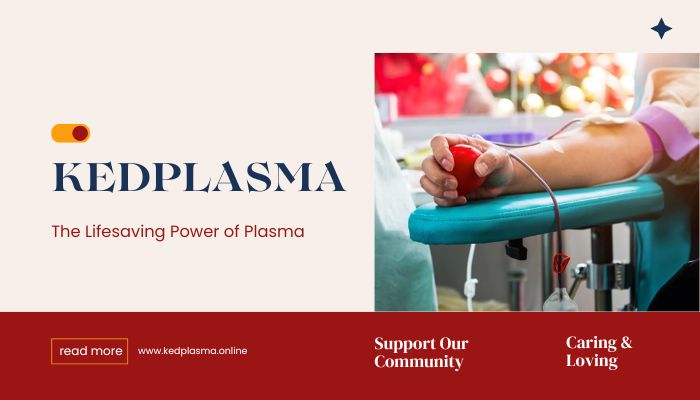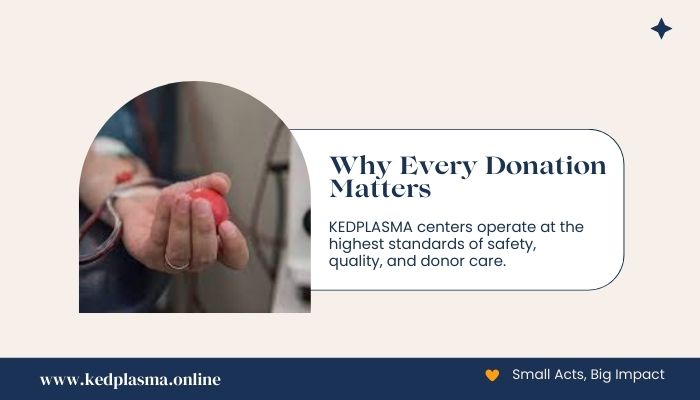Each day across America, thousands of patients rely on plasma-derived medications to treat chronic illnesses, recover from traumatic injuries, and fight life-threatening diseases. Behind each treatment is a donor who took time to visit a KEDPLASMA center and donate this vital biological resource. While the process may seem routine to regular donors, the impact of each donation extends far beyond the donation chair.
The Lifesaving Power of Plasma
Plasma, the clear, straw-colored liquid portion of blood, makes up about 55% of your total blood volume. This remarkable substance contains proteins, antibodies, and clotting factors that are essential for numerous medical treatments. Unlike other bodily fluids, plasma cannot be artificially manufactured – it must come from human donors.
When you donate at KEDPLASMA, your contribution becomes the foundation for therapies that treat patients with:
- Primary immunodeficiency diseases – conditions where the immune system is missing or functions improperly
- Hemophilia and other bleeding disorders – conditions where blood doesn’t clot properly
- Alpha-1 antitrypsin deficiency – a genetic disorder that can cause lung and liver disease
- Severe burns and shock – plasma helps restore blood volume and maintain blood pressure
- Trauma and surgical complications – plasma contains clotting factors essential for stopping bleeding

A single plasma donation can help produce multiple medications, potentially benefiting several patients from just one donor session.
The Journey of Your Donation: From Arm to Treatment
Have you ever wondered what happens to your plasma after you leave the donation center? The journey from donation to treatment involves several sophisticated steps:
- Collection: During plasmapheresis at KEDPLASMA, your blood passes through specialized equipment that separates plasma while returning other components to your body.
- Testing: Your donation undergoes rigorous testing for safety and quality.
- Freezing: The plasma is quickly frozen to preserve vital proteins.
- Transportation: The frozen plasma is transported to manufacturing facilities.
- Fractionation: At specialized facilities, your plasma undergoes a process called fractionation, which separates different proteins based on their size, charge, and solubility.
- Purification: Each protein fraction undergoes extensive purification.
- Manufacturing: The purified proteins are used to create specific medications.
- Distribution: The finished medications are distributed to hospitals, clinics, and pharmacies.
- Treatment: Finally, patients receive these life-saving treatments.
This complex process typically takes 7-12 months from donation to finished medication, highlighting the importance of regular donations to maintain a steady supply.
Real Lives Changed by Plasma Donations
Behind the scientific processes and medical terminology are real people whose lives are transformed by plasma donations. Consider these experiences:
Emma’s Story: At age 2, Emma was diagnosed with primary immunodeficiency. Without regular treatments made from donated plasma, she would be vulnerable to potentially fatal infections. Thanks to plasma donors, Emma is now an active 10-year-old who enjoys soccer and dance.
James’ Experience: After a severe car accident left him with critical injuries and significant blood loss, plasma-derived products helped stop his bleeding and stabilize his condition. Emergency medicine specialists credit plasma transfusions as crucial in saving his life.
Sarah’s Journey: Living with Alpha-1 antitrypsin deficiency, Sarah requires weekly infusions of alpha-1 proteinase inhibitor derived from plasma. “Each time I receive treatment, I’m grateful for the donors who made it possible,” she says. “They’re giving me the ability to breathe.”
Why Every Donation Matters: The Growing Need for Plasma
The demand for plasma-derived medications continues to grow for several reasons:
- New treatments: Medical advances have created new therapies requiring plasma components.
- Aging population: As the population ages, more people develop conditions requiring plasma-derived medications.
- Improved diagnosis: Better diagnostic tools identify more patients who can benefit from plasma therapies.
- Limited substitutes: For many conditions, there are few or no alternatives to plasma-derived treatments.

The COVID-19 pandemic highlighted the critical importance of plasma. Doctors used convalescent plasma from recovered patients as a treatment option, increasing the need for regular plasma donations.
The KEDPLASMA Difference
KEDPLASMA centers operate at the highest standards of safety, quality, and donor care. The organization is committed to:
- Donor safety: Rigorous screening processes and state-of-the-art collection technology ensure donor wellbeing.
- Quality control: Comprehensive testing and handling procedures maintain the integrity of every donation.
- Donor experience: Comfortable donation environments and professional staff make the process as pleasant as possible.
- Community Impact: KEDPLASMA centers become vital parts of their communities, providing both health benefits through plasma collection and economic benefits through compensation and employment.
Beyond Donation: The KEDREWARDS Program
KEDPLASMA recognizes the valuable contribution donors make and offers the KEDREWARDS program as a token of appreciation. While many donors are primarily motivated by helping others, the KEDREWARDS program provides tangible benefits for your time and commitment.
Through KEDREWARDS, you earn points with each successful donation, which can be redeemed for various rewards. This program represents KEDPLASMA’s commitment to recognizing the significant impact of each donor’s contribution.
How to Maximize Your Donation Impact
To ensure your plasma donation has the greatest possible impact:
- Maintain regular donation schedules: Consistent donations help maintain steady supplies.
- Follow pre-donation guidelines: Proper hydration, adequate rest, and a protein-rich meal before donating optimize your plasma quality.
- Refer friends and family: Expanding the donor base helps meet growing demand.
- Stay informed: Understanding the importance of your donation helps maintain motivation.
- Utilize KEDExpress: This time-saving service allows you to complete questionnaires ahead of time, streamlining your visit and potentially allowing more donations.
Who Can Donate? Understanding Eligibility
KEDPLASMA welcomes donors who meet these general requirements:
- Age between 18 and 65 years
- Weight at least 110 pounds
- Pass a medical screening
- Provide valid identification
- Meet general good health criteria
Specific medical conditions, medications, or recent activities may affect eligibility, which is why KEDPLASMA conducts thorough screenings before each donation.
The Future of Plasma Donation and Treatment
Research continues to uncover new applications for plasma-derived therapies. Scientists are exploring treatments for additional autoimmune disorders, neurological conditions, and other complex diseases.
As medical science advances, the need for plasma donors will continue to grow. By donating at KEDPLASMA today, you’re not only helping current patients but potentially contributing to breakthrough treatments of tomorrow.
Ready to Make a Difference?
Your decision to donate plasma at KEDPLASMA creates ripples of positive change throughout the healthcare system. A single hour of your time can translate into years of improved quality of life for patients dependent on plasma-derived medications.
Whether you’re a first-time donor curious about the process or a regular contributor, remember that each donation matters. Behind every treatment is a donor who chose to give, and a patient grateful for that decision.
Visit your local KEDPLASMA center today to learn more about becoming a donor. Together, we can ensure that life-saving plasma treatments remain available to all who need them.
Frequently Asked Questions About Plasma Donation
Q: How long does the donation process take? A: First-time visits typically take 2-3 hours, including registration and screening. Return visits usually take 1-1.5 hours.
Q: How often can I donate plasma? A: Eligible donors can donate up to twice in a seven-day period, with at least one day between donations.
Q: Is plasma donation safe? A: Yes. The process is FDA-regulated, performed by trained professionals using sterile, single-use equipment. Your body naturally replaces the donated plasma within 24-48 hours.
Q: Will donating plasma weaken my immune system? A: No. Your body quickly replaces the donated plasma, and the donation process does not impair your immune function.
Q: How should I prepare for donation? A: Get plenty of rest, drink extra water, eat a protein-rich meal within 3 hours before donating, and avoid fatty foods and alcohol before donation.
By choosing to donate plasma at KEDPLASMA, you become part of a vital healthcare solution that transforms lives every day. Your donation truly is the gift of life.
Conclusion: The Extraordinary Gift of Plasma Donation
Your plasma donation at KEDPLASMA represents one of the most direct ways to impact another person’s life positively. In a world where we often feel disconnected from the results of our actions, plasma donation offers a tangible connection between your generosity and someone else’s healing.
Every time you sit in the donation chair at KEDPLASMA, you’re not just giving plasma – you’re giving hope to a child with immunodeficiency, strength to someone recovering from trauma, and quality of life to those with chronic conditions. Your donation becomes part of a global healthcare system that depends on the kindness and commitment of donors like you.
Here’s a revised version with reduced passive voice:
The true value of plasma donation goes beyond points earned or compensation received—it lies in the lives it transforms and the moments it makes possible. A premature infant takes their first breath because plasma-derived treatments saved their life. A grandmother attends her grandchild’s graduation thanks to regular therapies. These moments happen because someone like you chooses to donate.
As you consider becoming a KEDPLASMA donor or continue your donation journey, remember that you’re part of something extraordinary – a community of donors whose contributions create ripples of healing that extend far beyond what we can see. Your plasma truly is the gift of life, and that makes you nothing less than an everyday hero to those who depend on your generosity.
Take the first step today. Visit KEDPLASMA, roll up your sleeve, and join the thousands of donors who are quietly saving lives, one donation at a time.